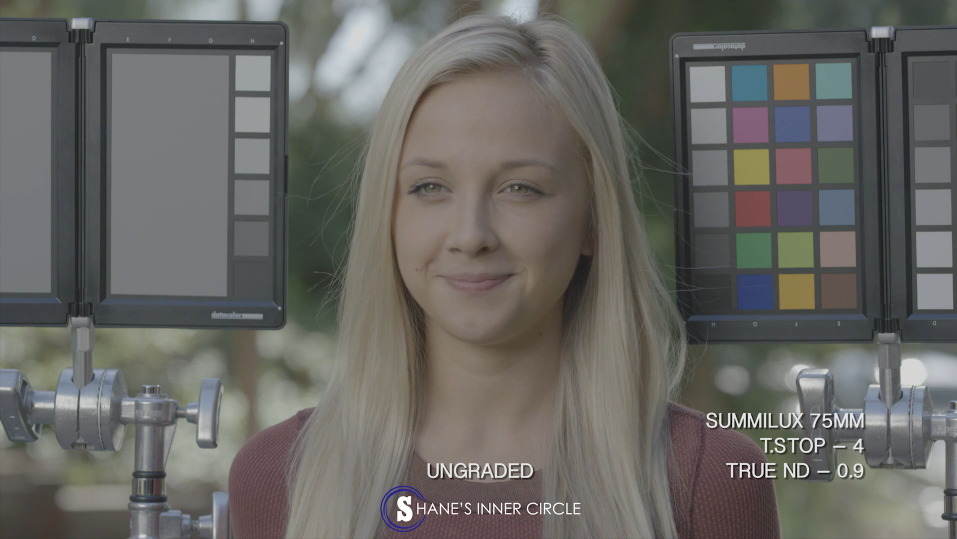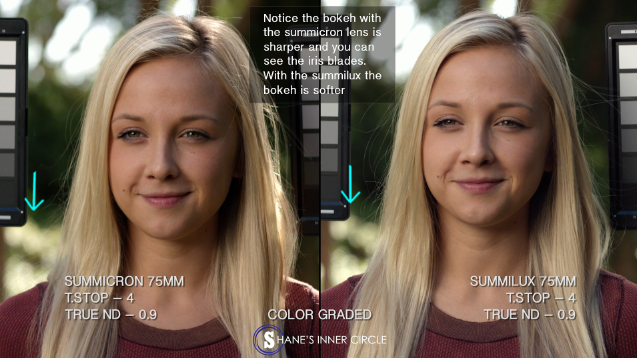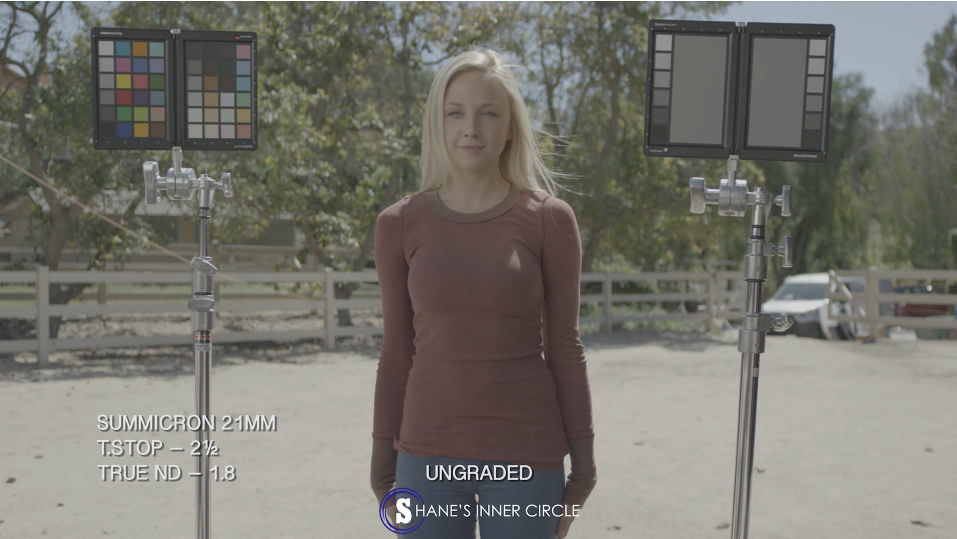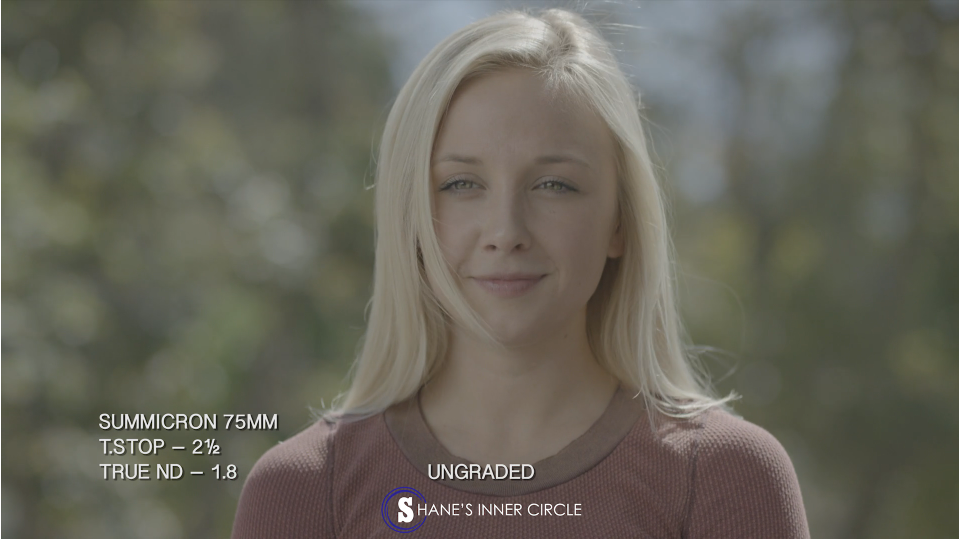Lens Test: Leica Summicron-C vs Leica Summilux-C
Today we are comparing Leica Summicron-C lenses to Leica Summilux-C lenses. We will be looking at similarities and differences between the lenses. It’s important to compare lenses so you can really find how each lens reads your talent.
Leica Summicron-C 21/75mm VS Leica Summilux-C 21/75mm
Here are the specs:
We are going to compare the ungraded look of the Leica Summicron-Cs with the Leica Summilux-C lenses so you can really see the different warmth of the lenses.
Here we have an ungraded image of our model Monette taken with the 21mm Summicron.
Below we have our 21mm Summilux result.
If you look at the two results side by side, the Summilux is warmer and has more yellow than the Summicron. The Summicron is a much whiter lens.
Another thing to note is that the background of the Summilux is brought to the foreground and has a flatness to it. It loses that three-dimensional quality but is sharper than the Summicron. The difference is subtle, but if you look at her face, you can see the Summilux has more sharpness than the Summicron. The curb in the background also looks closer to her with the Summilux.
Here’s the graded version. On this grade, the color is extreme because that was the direction we were going for with Into the Badlands. The color grade helps us see the contrast of the lenses.
You can see that with the color grade, the Summilux is still a lot more yellow, and the Summicron is still a whiter lens.
The background looks pretty similar with both lenses. The flatness is there, and the background with the Summilux still seems closer to the foreground. When looking at contrast, the Summicron seems to have a little more contrast than the Summilux. The Summicron is more saturated, so that’s why it has more contrast.

Notice the Leica Summicron has more saturation and contrast, and the Leica Summilux still has a flatter image.
Close-Ups
Now we have the close-ups, shot with a 75mm Summicron and 75mm Summilux lens. For the close-up ungraded image with the Summicron, notice the whiter image from this lens.
With the Summilux, notice the yellow of the lens.
In the side-by-side comparison, it is really apparent that the Summilux lens has a lot more yellow than the Summicron.
Here is the graded version so we can see the contrast better.
The 75mm Summilux looks less yellow than the 21mm Summilux, but both Summilux lenses still look more yellow than the Summicrons. With the side-by-side comparison below, what I’m seeing just in the 75mm is that the Summilux is flatter. Looking at her face, her face is flatter with the 75mm Summilux than it is with the 75mm Summicron.
With the Summicron, if you look at camera left over her right shoulder at the bokeh, we are seeing the blades of the iris and the bokeh is doing some stop signing.
The Summicron felt creamier. It wasn’t so hyper-sharp. We knew we were dealing with a fast-shooting tv show, and we were shooting in New Orleans where it’s humid. People would be sweating, and the makeup on the talent would be affected by this, so we wanted to use creamier, less hyper-sharp lenses.
When shooting with the Summicron lenses, I felt like I was shooting with Panavision Primo lenses. The qualities I love with the Panavision Primos, I saw with the Summicron lenses both onscreen and while shooting with them. There was detail and creaminess but still a sharpness.
Taking the Lenses to the Backyard
Now we’re set up in the backyard. Monette is backlit, and there are flowers in the background, so we can look at the contrast and color with the lenses. Here are ungraded images with the 75mm Summicron lens and the 75mm Summilux lens.
Again, the Summicrons seem more neutral and white, and the Summilux looks more yellow. Monette’s face has more yellow with the Summilux.
Now let’s look at our graded version.
With the Summilux, you can immediately see a sharpness. She’s definitely sharper on her face, and if you look underneath her chin, you can see much more detail and definition with the Summilux. The Summilux is a sharper piece of glass, and the Summicron tends to cream out her face and there is less detail with that lens.
At the Corral, a Less Controlled Environment
Next, we took the Summicron and Summilux lenses into the corral, where we have a lot of white warmish bounce coming off of the ground. Starting with our 21mm lenses, we have our Summicron and Summilux 21mm ungraded images.
Looking at the background, I see a little size difference with the lenses. With the Summilux, the background seems closer and the image is flatter. The Summilux brings the fence line and all the trees closer. It’s a subtle difference because both lenses are engineered with computers to be as flat as possible.
Moving onto the graded versions:
Looking at the side by side, the Summilux still looks more yellow. The flatness looks about the same, but the Summilux makes her look younger than the Summicron. You can really see how much younger she looks with the Summilux with the 75mm lens comparison.
Notice that with the Summicron, Monette’s wrinkles look a slight bit more pronounced, making her look older than she looks with the Summilux.
Looking at the side-by-side comparison, you really can see that she looks younger with the Summilux lens.

Monette’s face looks younger with the Leica Summilux. Note her face looks more full and wider. Because the glass is engineered to be flatter, her face is wider than with the Leica Summicron.
You can also see this with the graded version of the 75mm lens comparison.
With the Summilux, her face looks more filled out, making her look younger than she looks with the Summicron 75mm. The Summicron makes her look more sophisticated. It’s strange, but these are the kind of things you look for when you’re comparing lens tests.
The Bottom Line
Leica Summicron-C:
- Makes Monette look a bit older when compared to how she looks with the Leica Summilux lens
- Is a whiter lens
- Creamier, not as hyper-sharp as the Summilux
- More saturated, more contrast
- Slightly more three dimensional
Leica Summilux-C:
- Makes Monette look younger when compared to how she looks with the Leica Summicron lens
- Is a yellower lens
- Sharper than the Summicron
- A little less saturated, less contrast
- Flatter, slightly less three dimensional
Technical Specs:
All videos were edited on HP Z840 workstations using HP Z24x DreamColor monitors.














































Thanks for putting this together. Every time I see a lens test you do it helps train my eyes to see and notice the subtle differences between similar lenses.
Thanks so much, loved to watch it (and even more so your Summilux vs S4 comparison). You did a great job in these tests pointing out the flat field disadvantages which are very real (I even find them in binoculars, which takes the argument to the next level, having a flat looking space EVEN in a 3D view…)
One correction: Both the Summicron and the S4 have 8 aperture blades (you can even count looking at your footage). Now if you could ever convince Cooke to rethink their aperture construction. But they might use it as a fingerprint they put in all productions using Cookes. Sooner or later you´ll see their apertures.
So S4s are shaper, contrastier, Summicrons have smoother bokeh. I do see a harsher bokeh in all Cooke samples which surprised me. I see in the 21mm Cooke quite pronounced bright ring bokeh in the highlights in the distant trees which hints to slightly overcorrected spherical aberration (with the Leica probably being under corrected, hence smoother bokeh, but less punch). The harsher bokeh in the Cookes looks to me as if the lens has more depth of field, improving the 3D impression. Canon´s Larry Thorpe published a fine paper about Canon´s 4K cinema lenses and the way they optimize spherical aberration and contrast and bokeh.
Now if you ever get your hands on the Varicam, I just graded some footage, it shines brightly at 5000 ISO where the Dragon is totally unusable.
And of course the C300II, I have hardly seen any well graded footage so far. And Cooke S4minis, which would be my lenses to go with. Would love to pay for the downloads as with your C1002 test (which was great and to the point).
Thank you so much for your kind words. 8 blades. Copy that. Weird. It said 5 on the website. I love the look of the Cookes. Always have. But lenses are the soul of the film and you need to pick the lens that will best deliver that soul and emotion.
Hey Shane,
thanks for taking the time to share these tests! Quite interesting to see those lenses in comparison and hear your thoughts about it. I’m trying to see what you’re describing. Do you think that the outdoor tests make it a bit harder to find such minute and subtle differences in lenses? It seems that the change in lighting between the different lenses just by the sun moving forward has quite a strong impact in the way I perceive her separation from the background. Just the little extra light on the street in the first setup and the rim light on the right shoulder make such a strong difference in how she stands out – as well as the light on the bushes behind her image left.
Also it seems that on both the wide shots the camera is slightly closer (it’s not just a slight difference in focal length but actually a slightly closer perspective when you look at the parallax – might just be the balancing dovetail), which results in a slightly shallower depth of field on the Summilux shots which definitely affects the separation.
Looking forward to seeing the Ultras against the Leicas =)
Cheers,
Dan
Hi Dan, go to my article called “Why Do We Want Flat Glass?” with Leica. I did a controlled environment with these tests and you can see the difference is huge. https://www.filmmakersacademy.com/cinematography-online-why-do-we-want-flat-glass/